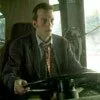A man in a summer-weight brown suit, beige shirt and dark tie boards the bus. He has a black bag over one shoulder and a backpack. In his arms he carries an infant girl with wispy blonde hair wearing a pink dress. He expertly manages the maneuver required to simultaneously unload and reposition his baggage while seating himself and his daughter as the bus jerks and starts down the street.
A young boy wearing a backpack and carrying a cell phone boards the bus. I hear a woman give the driver instructions as the boy feeds coins one at a time into the fare box. The boy takes a seat just inside the door and the woman walks away pushing a stroller. She waves. The boy, however, is intently focused on his cell phone.
A Sacramento State student wearing a Manchester United shirt loads his bike on the front of the bus and boards. He takes a seat. On the back of his shirt is Wayne Rooney's name. No doubt the student is celebrating yesterday's victory by the Red Devils over my favorite team, Barcelona. Now it will be an all-English Champions League final in Moscow on May 21. I prefer Chelsea over Liverpool. The two meet this afternoon to decide who will play Manchester United.
A young couple are cuddling in the seat in front of me. I'm in the first elevated row in the back. This is where I was seated last night with the wife. The cuddling couple were on that bus as well and also in the same seat. Transit symmetry of sorts.
A man in a security guard uniform sits across from the boy in the front. There's nothing to guard.
A forty-something man with an expensive looking polo shirt, immaculate hair cut and stylishly trimmed mustache takes a seat. As he shifts his weight one of his bags falls into the aisle with a loud thud. He makes no move to pick it up. I notice then that he has a hearing aid buried deep in his ear. Eventually he notices the missing package and finds it in the aisle.
A guy behind me and across the aisle is loudly talking on a cell phone. His feet are up and over the back of the seat in front of him. He wants someone to burn a CD for him.
Rumbling and bouncing. Speeding up and slowing down. Stopping and starting.
I hear a motherly female voice tell the boy in the front of the bus that the next stop is his. It sounds as if the voice is coming from behind me. The bus makes the turn onto Morse and pulls to a stop in front of Kaiser Hospital. "This is where you get off," the female voice says. Only then do I realize it's the driver. The boy says "Thanks" and leaves.
The towheaded girl is quiet in her father's lap. The Manchester United fan is manipulating buttons on his phone using only his thumb. It's a very big thumb and a very small phone. The security guard gets up to get off and realizes he's one stop early. Not a problem. The driver continues to the next stop. The guy on the cell phone now has his feet on the floor of the bus. He is talking quietly to his cell phone customer service representative. He is asking about text message pricing. "Fifteen cents each?" he asks. A pause. "You can do that?" A lengthy pause.
The bus is entering the realm of off-campus student housing. Each stop adds another Sac State rider and the odd extra passenger heading to points between.
The guy in the polo shirt has his arm draped along the back of his seat. He studies the scenery as we roll along. In front of him, the little girl is making little girl noises and her father is making comforting father noises and otherwise giving her his attention. The father and daughter are regulars on the No. 82. He has another daughter, a few years older. Perhaps she's in preschool now.
We arrive at Sac State and the man in the suit with the infant girl gathers his two bags and leaves the bus. On the sidewalk, he raises his daughter and places her on his shoulders, her legs wrapped around his neck. Off they stride into the campus. Behind them the Manchester United fan has retrieved his bike and rides off.
A half-dozen passengers ride with me to 65th Street where we have an accident -- shortly after I get off the bus, the inbound train arrives, shaving 15 minutes off my morning commute.
Just another unremarkable morning on the bus.































